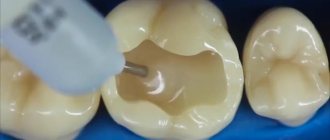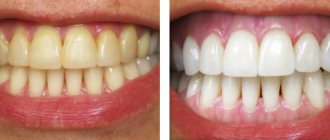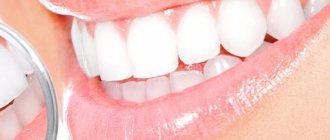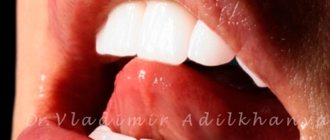Date of publication: 18-01-2019 Date of update: 17-02-2021
Author of the publication: Bogatyreva Radima Muradinova Periodontist
The whitening procedure is often perceived as aesthetic, but it also has many positive properties in terms of health improvement. Sometimes patients refuse a snow-white smile because they are embarrassed to discuss the procedure with a dentist or believe myths from the Internet. In this article you will find answers to the most popular questions about teeth whitening that are asked to dentists at the Clarimed clinic.
When is whitening needed?
Different people have different shades of enamel. This is due to genetics, lifestyle, and the quality of hygiene procedures. Changing the color of teeth can have several reasons:
- insufficient oral care;
- artificial or natural colors contained in food;
- bad habits;
- jaw injuries, some systemic diseases;
- taking medications;
- age-related changes.
If any of these reasons are present in your life, or you simply want to lighten your enamel a few shades to make your smile look healthier and more beautiful, this is an indication for whitening.
Whitening a dead tooth: features and methods
Modern dentistry offers various methods to maintain healthy and crystal white teeth.
But situations often arise when the only way to save a tooth is to remove the pulp. Although today it is very rare to use materials for canal filling that can change the shade of the enamel, after removal of the nerve, darkening of the tooth surface is observed over time due to its necrosis. Such modifications significantly spoil the smile and cause aesthetic discomfort. Dentists at the Berezka clinic whiten a dead tooth and after the procedure it is completely no different from other units of the dentition.
Does the procedure have any contraindications?
As with any manipulation in the dental chair, there are contraindications, but not many of them:
- pregnancy and breastfeeding;
- oncological diseases;
- allergies to the drugs used.
All other problems - caries, inflammation of the oral mucosa and gums - are considered relative contraindications. After they are eliminated, bleaching can be done.
Even if you take good care of your teeth, whitening will have the effect of making your smile even more aesthetically pleasing.
Is it possible to whiten metal-ceramic crowns?
Unfortunately, it is impossible to achieve perfect whitening of fillings and metal-ceramic crowns. So, for example, modern dental ceramics is a fairly dense and hard material, so the brightening compounds used today have practically no effect on it.
The photo shows a metal-ceramic crown
But if the restored areas and prosthetic structures are located in the posterior parts of the jaw, the front teeth can be whitened. Then the difference in shades will not be noticeable. Otherwise, it will not be possible to achieve uniform whitening and an aesthetically pleasing smile. To do this, you will have to look for other solutions to the problem.
Which teeth should not be whitened?
Whitening is not carried out if there is untreated caries in the oral cavity, exposed tooth necks, or enamel damage. If there are composite fillings, the procedure will give an uneven effect, because the color of inorganic materials is not subject to change. The most correct thing would be to install a temporary filling and carry out whitening before the final restoration of the tooth.
The procedure is also not carried out in the presence of braces due to the unguaranteed and uneven result. Exposure to chemicals on the enamel of hypersensitive teeth is undesirable.
Plastic dentures. Features of care
Not everyone has the opportunity to install expensive metal-ceramic teeth. An alternative in this case is budget plastic. This material is quite reliable and is able to maintain its original whiteness throughout its entire service life with proper care.
But the question of how to whiten plastic dentures arises when eating foods that have coloring properties. Smoking leaves its mark plus bad breath.
To remove plaque, special products are offered - Protefix, Corega, Rox. On average, once a month, the tablet is dissolved in water and a removable plastic structure is placed in the resulting solution for the time specified in the instructions. This procedure allows you to preserve the shade and extend the service life.
You can solve the problem of how to whiten dentures by contacting a specialized clinic. Specialists will select the necessary products to restore color.
How to whiten teeth at home?
All chemical preparations for teeth whitening at home, as well as professional ones, contain peroxide gels. They are applied using different devices:
- mouth guards – “covers” for teeth made of hypoallergenic plastic. They are filled with a special gel and worn for several hours a day;
- adhesive strips - stickers on teeth already impregnated with hydrogen peroxide or urea. A thirty-minute daily procedure will help brighten your smile by one or two shades in just a month;
- whitening gels and pencils - used in the same way as strips.
But Clarimed specialists recommend visiting a dentist before starting home whitening; our clinic even offers a free consultation; don’t risk the health of your teeth.
Professional whitening of pulpless teeth
Whitening a dead tooth in a dental office is a completely safe and most effective procedure. One of the popular methods of professional lightening is endobleaching. The procedure is carried out in the following order:
- First, the dentist removes the old filling from the pulped tooth;
- then a special bleaching agent is introduced into its internal cavity. In most cases this is sodium perbonate, if necessary a small amount of hydrogen peroxide is added to it;
- After this, the doctor installs a temporary filling. If it is necessary to re-inject the brightening reagent, the filling is removed again. The number of procedures depends on the degree of darkening of the tooth;
- Once the desired color is achieved, a permanent filling is placed on the tooth.
In addition to intracanal bleaching, the dentist may also suggest other methods, for example, the use of veneers or crowns.
Is it possible to whiten teeth at home?
Home whitening has a serious limitation - it does not carry risks if it is carried out on absolutely healthy teeth. If the neck of the teeth is exposed, there are cracks in the enamel and carious cavities, such procedures will only cause harm. Before using chemical gels, you should consult your dentist.
Folk remedies that are recommended for whitening are no less traumatic for enamel than professional chemical ones. The use of soda, charcoal, and lemon juice sometimes causes more harm than bad habits or injuries.
Whitening prognosis and complications
Whitening a dead tooth is a fairly serious procedure that involves chemical action on tooth enamel. Therefore, before carrying out it, you should familiarize yourself with possible complications:
- the fragility of the result obtained, which necessitates repeated bleaching;
- The enamel of a dead tooth does not always acquire the same shade as healthy teeth. Even after lightening, the enamel can stand out from the rest;
- the enamel coating of a pulpless tooth after bleaching becomes even more fragile, in some patients it even begins to crumble and collapse;
- When applying the whitening component, the gums are irritated, so it should be done with extreme caution in patients prone to gingivitis, periodontitis and other pathologies.
How often do you need to perform the whitening procedure to maintain the effect?
Teeth whitening using chemicals changes the condition of the enamel. Therefore, doctors do not recommend performing it more often than once every 2 years. Between procedures it is recommended:
- For the first month, avoid food and drinks with active dyes - red wine, coffee, brightly colored vegetables.
- Quit smoking - nicotine will quickly return the yellowish tint.
- Visit your doctor regularly to get rid of plaque and tartar.
- Use threads, special pastes, and electric brushes in home care.
Teeth whitening technology
As you may have noticed, in each unique case, it is necessary to look for a unique approach. But we can make a generalization about the technological process of professional teeth whitening! Firstly, professional cleaning is necessary to get rid of caries and other diseases. Secondly, it is necessary to decide on the location of the seals and select the necessary tactics of action. Thirdly - whiten the enamel! And, finally, insert new, lighter fillings, or veneers.
We think that now you will not have any questions about whether it is possible to whiten teeth with a filling. Modern technologies allow every person to have a snow-white smile, regardless of the specific situation and conditions. Smile so that people around you admire your smile. In fact, you will also be delighted with your snow-white teeth if you contact our clinic.
Are preparatory procedures necessary before lightening tooth enamel?
The process of preparing for teeth whitening takes place in several stages:
- examination of the dentist and identification of absolute and relative contraindications;
- sanitation of the oral cavity and installation of temporary fillings, if necessary;
- removal of tartar, plaque, polishing and fluoridation.
A few weeks before the procedure, it is advisable to start a course of medications to reduce sensitivity and strengthen the enamel. The doctor will recommend special gels and pastes for treating teeth.
At the patient’s request, the dentist will take impressions to make a special mouth guard for subsequent use at home. This will help prolong the effect of the professional procedure.
Carry out the whitening procedure at the Clarimed clinic, we guarantee excellent results
Teeth whitening with fillings on the front teeth is a way out of the situation
Dental fillings, unfortunately, do not whiten, however, if you plan to whiten the filled front teeth, first of all you need to carry out the teeth whitening procedure itself, and then wait a period of about two weeks, after which, at a second visit to the dentist, the teeth with fillings should be filled new to match your new, whiter color.
After whitening, a period of approximately two weeks is required before replacing fillings. This is because it takes a period for the color of your healthy teeth to stabilize after whitening. If caries is present, treatment and filling of the tooth must be carried out before safe whitening. Over time, the color of the tooth filling will change and will not match the color of the whitened teeth; in this case, the patient is recommended to renew the tooth filling by waiting the period of time recommended by the dentist.
How does non-professional whitening affect tooth enamel?
Frequent and uncontrolled use of chemicals for treating teeth leads to the gradual destruction of enamel. It becomes more porous, absorbs dyes faster, becomes cracked and loses its whiteness. The decrease in mineralization of the outer layer and its destruction can be partially compensated with the help of fluorine-containing preparations.
But provided that the whitening procedure is carried out in a dental clinic, in compliance with the recommendations of the attending physician, all risks and negative consequences will be minimized.
We hope that the whitening procedure is now clearer to you and you are ready to achieve a Hollywood smile. Call or sign up on the website:
We also recommend paying attention to the popular service - installation of veneers - snow-white teeth like superstars!
Why does a dead tooth turn dark?
Teeth that lack nerves inside are considered dead. The surface of such processes is characterized by a tendency to change color and the appearance of dark spots. The reasons for the darkening of a pulpless tooth are as follows:
- lack of food. After the nerve is removed, the power to the tooth stops. Moisture leaves the enamel, nutrients are not supplied by the nerve endings, which leads to darkening;
- increased vulnerability. Without regular feeding, the tooth becomes very vulnerable. Pores form on the surface of the enamel, through which various coloring substances from the food consumed penetrate into the internal tissues. These dyes change the color of the enamel.
These are the most common reasons why tooth enamel darkens. In such cases, superficial bleaching of the dead tooth will help restore whiteness. But there are also often cases where a tooth has lost its original color due to bleeding during pulp removal. As a result, the enamel becomes reddish or purple. Classic whitening will not provide results in such situations; a more complex procedure will be required.











